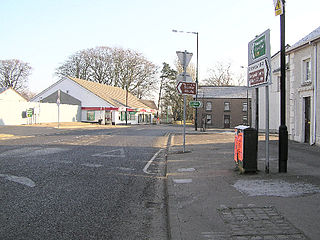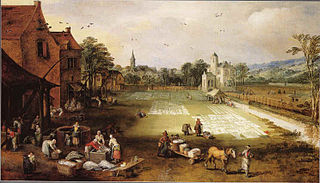Related Research Articles

Linen is a textile made from the fibers of the flax plant.

Lisburn is a city in Northern Ireland. It is 8 mi (13 km) southwest of Belfast city centre, on the River Lagan, which forms the boundary between County Antrim and County Down. First laid out in the 17th century by English and Welsh settlers, with the arrival of French Huguenots in the 18th century, the town developed as a global centre of the linen industry.

Maghera is a small town at the foot of the Glenshane Pass in County Londonderry, Northern Ireland. Its population was 4,220 in the 2011 Census, increasing from 3,711 in the 2001 Census. It is situated within Mid-Ulster District, as well as the civil parish of Maghera, which it was named after, and the former barony of Loughinsholin.

Irish linen is the name given to linen produced in Ireland. Linen is cloth woven from, or yarn spun from, flax fibre, which was grown in Ireland for many years before advanced agricultural methods and more suitable climate led to the concentration of quality flax cultivation in northern Europe.

Beetling is the pounding of linen or cotton fabric to give a flat, lustrous effect.
Milford or Millford is a small village about one mile southwest of Armagh in County Armagh, Northern Ireland. It is within the Armagh City and District Council area. It had a population of 569 people in the 2011 Census.

Donaghcloney or Donacloney is a village, townland and civil parish in County Down, Northern Ireland. It lies on the River Lagan between Lurgan and Dromore. In the 2011 Census it had a population of 1701. It is colloquially referred to as "The 'Cloney" by locals.

Sion Mills is a village to the south of Strabane in County Tyrone, Northern Ireland, on the River Mourne. In the 2001 Census it had a population of 2,050 people. It is a tree-lined industrial village and designated conservation area, particularly rich in architectural heritage.

Tobermore is a small village in County Londonderry, Northern Ireland. It lies 2.5 miles (4.0 km) south-south-west of Maghera and 5.5 miles (8.9 km) north-west of Magherafelt. Tobermore lies within the civil parish of Kilcronaghan and is part of Mid-Ulster District. It was also part of the former barony of Loughinsholin.
Upperlands is a small village in County Londonderry, Northern Ireland. It is situated 3 miles north east of Maghera. It lies within the civil parish of Maghera, the historic barony of Loughinsholin, and is situated within Mid-Ulster District. In the 2011 Census it had a population of 561 people.
Events from the year 1830 in Ireland.

Banbridge is a town in County Down, Northern Ireland. It lies on the River Bann and the A1 road and is named after a bridge built over the River Bann in 1712. It is situated in the civil parish of Seapatrick and the historic barony of Iveagh Upper, Upper Half. The town began as a coaching stop on the road from Belfast to Dublin and thrived from Irish linen manufacturing. The town was home to the headquarters of the former Banbridge District Council. Following a reform of local government in Northern Ireland in 2015, Banbridge became part of Armagh City, Banbridge and Craigavon Borough Council. It had a population of 16,637 in the 2011 Census.

A bleachfield or bleaching green was an open area used for spreading cloth on the ground to be purified and whitened by the action of the sunlight. Bleaching fields were usually found in and around mill towns in Great Britain and were an integral part of textile manufacture during the Industrial Revolution.
James Johnston Clark was a Unionist politician in Ireland.

For much of its history, the city of Fall River, Massachusetts has been defined by the rise and fall of its cotton textile industry. From its beginnings as a rural outpost of the Plymouth Colony, the city grew to become the largest textile producing center in the United States during the 19th century, with over one hundred mills in operation by 1920. Even with the demise of local textile productions during the 20th century, there remains a lasting legacy of its impact on the city.

The Linen Quarter is a vibrant area of Belfast city centre. The name is derived from the great many linen warehouses that are still present in the area. The Linen Quarter is host to some of the major cultural venues of Belfast, including the Ulster Hall and Grand Opera House, alongside a large number of hotels, bars, restaurants and cafes. The district also includes the main transport hub of Belfast.

The South African International Exhibition held in Cape Town, Cape Colony was a world's fair held in 1877 which opened on 15 February by Henry Bartle Frere.

The Game of Thrones Tapestry is a hand-crafted tapestry, woven by hand on a jacquard loom, with additional embroidery. The tapestry tells the entire story of the television show, Game of Thrones. It consists of seven 11-metre-long panels and one 10.5-metre panel. The eight panels depict scenes from each episode and include images of crew at work. The tapestry was commissioned by HBO and Tourism Ireland, the tourism bureau of Northern Ireland. where HBO filmed much of the series.

The Knockoneil River sometimes spelled Knockoneill and is even called Clady River this river is a small to medium sized river in Northern Ireland located near Maghera and is a major artery river which merges with the Grillagh River to form the Clady River. It flows eastwards towards Swatragh, Knockoneil is a townland in the rural area of Slaughtneil and is the townland the rivers named after .The Knockoneil starts its course and it is only about 10 to 15 feet wide at this point after this the river widens as it passes through Swatragh and onwards to Upperlands where a lot of hydro energy from the river is used for Clarke's mill. It flows onwards outside Culnady where it widens quite drastically round the old Dunglady Bridge around 20 to 30 feet across it then flows onwards where it merges with the Grillagh river to form the Clady River. Knockoneil River Means Nialls Hill River.

Linenhall is an area in the north inner city of Dublin, Ireland which was previously the site of a complex of buildings and streets associated with the linen trade. It was also temporarily a barracks, and was largely destroyed during the Easter Rising in 1916.
References
- ↑ "Ireland's oldest linen fabric mill" . Retrieved 1 May 2017.
- ↑ Brankin, Una (23 October 2014). "How new life is being spun into Northern Ireland's glorious linen industry" . Retrieved 1 May 2017.
- ↑ "Fire at William Clark and Sons Maghera linen mill". Northern Ireland News. 27 February 2017. Retrieved 1 May 2017.
Article contains translated text from William Clark & Sons on the French Wikipedia retrieved on 1 May 2017.